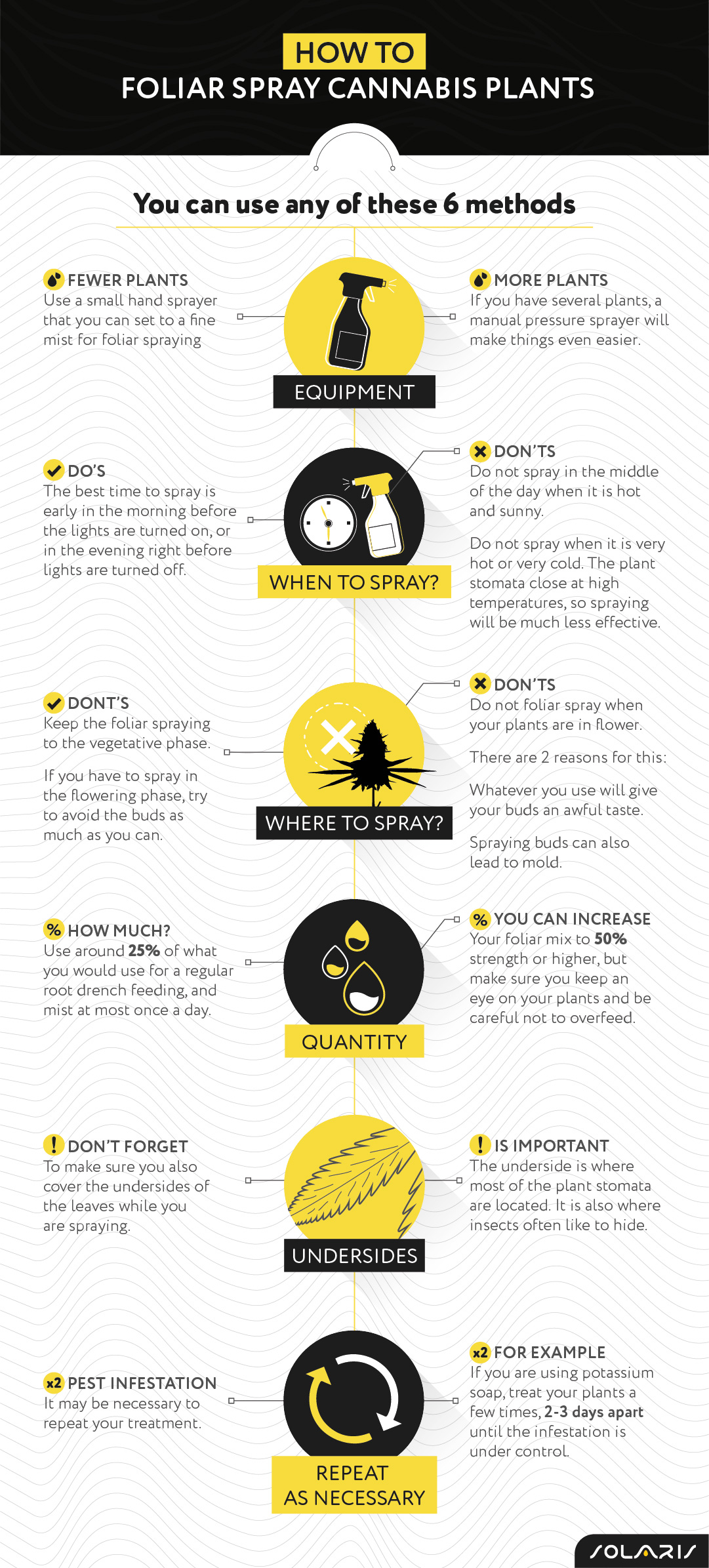Foliar feeding is a method of nourishing your plants by applying nutrients directly to the leaves. Cannabis leaves readily and swiftly absorb nutrients, allowing sick plants to heal quickly or healthy plants to thrive.
This technique provides a rapid boost to your plants, ultimately producing larger, better, and more bud-filled harvests. That being said, foliar spraying cannot replace a standard root-feeding regimen. Instead, it provides a quick way to get supplementary nutrients to your plants.
While foliar feeding your plants does not require any special growing skills, it can nevertheless be helpful to know how to do it right so you can get the best results.
What is foliar feeding?
Foliar feeding essentially means that you spray fertilizer straight onto the leaves. It provides nutrients via foliage rather than roots. The process has been the subject of many scientific and anecdotal studies, prompting many growers to use it in their growing programs.
With other feeding methods, cannabis typically absorbs nutrients through its roots. However, foliar feeding delivers nutrients directly to the leaves where they are taken in by the stomata.
Stomata are the pores found on the epidermis (skin) of the leaves. Generally, the stomata are responsible for the gas exchange between carbon dioxide and oxygen, but when they are open, they can also take in nutrients.
These stomata can absorb the nutrients at a rapid pace, faster than top dressing nutrients or liquid feeding. You can also easily isolate and treat specific plants in your garden that are showing deficiencies without having to feed your entire garden.
The benefits of foliar feeding
Before we dig into the benefits of foliar feeding, you should know that maintaining the health of your soil and root system is extremely important, and cannot be substituted with regular foliar feeding. With that said, foliar spraying does have many advantages:
- Fast and effective: When foliar spraying, you are directly supplying nutrients that will be available immediately for your plants to use. It is a quick way to feed starving plants, and ideal if you need to act fast when your plants are sick. Plus, almost all nutrients are taken in by the plant when foliar spraying.
- Supplies micronutrients: It is relatively common for cannabis plants to get sick from a lack of calcium, iron, zinc, manganese, and other micronutrients. A foliar spray is usually the most effective remedy for quickly topping up micronutrient levels so your plants can continue to thrive.
- Helps with diseases, pests, and stress: If your plants are plagued by pest infestations or suffering from mold or other common pathogens, a foliar spray is usually the best way to provide immediate help.
- No nutrient buildup in the soil: Giving nutrients directly to your plants via the leaves means there is no risk of nutrients building up in the substrate. Soil is a great buffer, and it can ultimately accumulate a lot of minerals, which can throw off your plants’ ability to uptake nutrients through the roots. On the other hand, there may be occasions where you want to feed your plants, but do not want to overwater them.
When is the right time for foliar feeding?
Foliar feeding works wonders at raising your plants to their full potential, but only when they are in the vegetative phase or the first few weeks of flowering. You do not want to foliar feed your plants with developing buds and risk nutrient residue contaminating your hard work.
Once again, if you notice any plants showing signs of nutrient deficiencies, foliar feeding is a great solution. Plants most commonly display calcium/magnesium deficiency or a nitrogen deficiency, which can be remedied with a quick foliar spray.
What to use as a foliar spray
There are all kinds of recipes you can foliar spray your cannabis with. The purpose of these spray mixes ranges from providing your plants with essential nutrients to deterring pests, to getting rid of mold and fungus.
The good thing is, many of these recipes make use of natural ingredients. They are non-toxic and safe to use. In addition, most of the ingredients for a foliar spray are easy to obtain and inexpensive. Here are some good examples:
Neem oil
Neem oil is a tried and tested natural solution that prevents many of the most common cannabis pests. It is one of the essentials that every cultivator should have on hand. Neem oil is effective in keeping aphids, spider mites, whiteflies, and thrips away from your plants. It also helps with powdery mildew and other plant diseases. Although less suited if you need to “knock out” an immediate infestation, spraying your plants prophylactically every 1-2 weeks with neem will greatly reduce the risk of pests.
Depending on your neem oil product, you will only need a small amount for your foliar spray. Some commercial neem oil products already contain an emulsifier so you can just mix it with water, usually at a 1:10 ratio. Make sure you read the instructions for the most accurate use.
Potassium soap
What neem oil is for prevention, potassium soap is for getting rid of cannabis pests. It is very good in combination with neem oil. Treat your plants with potassium soap first to kill the critters on contact, and follow it up the next day with neem to keep them at bay. Potassium soap is natural, non-toxic, and poses little risk of harm to your cannabis plant. For a potassium soap foliar spray, you will usually mix soap with water at a 1-2 percent concentration.
Aloe vera juice
Aloe vera juice is a true multi-purpose plant remedy that, when used as a foliar feed, will greatly benefit your cannabis. It provides plants with micronutrients such as magnesium, calcium, zinc, and manganese, and is rich in other beneficial compounds like amino acids and enzymes. Use aloe vera juice at the first sign of deficiency.
Likewise, aloe vera juice helps protect against environmental disease and stress. It contains numerous compounds with protective effects, such as acemannan, a polysaccharide with antiviral, antibacterial, and antifungal effects. Other compounds in aloe, saponins, help protect against microbes, fungi, mold, and certain types of insects.
To make a foliar spray using aloe vera, mix 2 teaspoons of fresh aloe gel with 4.5 liters of water. Shake well and administer right away using the “mist” setting on your sprayer. Be sure to mix the aloe gel well enough so that it does not clog the nozzle of your sprayer.
Other natural ingredients
If you look around on grower forums, you can find many more foliar spray recipes that use natural ingredients. For example, spraying plain milk is said to help with fungus and powdery mildew. A spray made with cayenne pepper is an effective insect deterrent, while cinnamon is another natural ingredient with pest-deterring and antifungal properties.
Before administering any of these foliar sprays, make sure to read up on the proper ratios
. Most of these sprays will be safe to use, but it is always a good idea to try them on just a few leaves first. If you do not notice any damage or discoloration the next day, it should be safe to use on your entire plant.
How to foliar spray cannabis plants

To use foliar feeding correctly, you will first need to understand a few fundamental tips and tricks:
- Get the right equipment: Use a small hand sprayer that you can set to a fine mist for foliar spraying. If you have several plants, a manual pressure sprayer will make things even easier.
- Spray in the morning or evening: Do not spray in the middle of the day when it is hot and sunny. Sunlight and heat can degrade the effectiveness of your foliar spray. What is more, water droplets on the leaves will have a lens effect that can burn your plants. The best time to spray is early in the morning before the lights are turned on, or in the evening right before lights are turned off. Do not spray when it is very hot or very cold. The plant stomata close at high temperatures, so spraying will be much less effective.
- Do not spray the buds: If possible, do not foliar spray when your plants are in flower. There are two reasons for this; Whatever you are using to spray may not be harmful, but it will give your buds an awful taste. What is more, spraying buds can also lead to mold. So keep the foliar spraying to the vegetative phase. If you have to spray in the flowering phase, try to avoid the buds as much as you can.
- Do not overfeed: When foliar feeding your plants, use around 25 percent of what you would use for a regular root drench feeding, and mist at most once a day. If necessary, you can increase your foliar mix to 50 percent strength or higher, but make sure you keep an eye on your plants and be careful not to overfeed. You will still want to follow your regular root-feeding schedule.
- Do not forget the undersides: When spraying, make sure you also cover the undersides of the leaves. The underside is where most of the plant stomata are located. It is also where insects often like to hide.
- Repeat as necessary: If you have a pest infestation, it may be necessary to repeat your treatment. For example, if you are using potassium soap, treat your plants a few times, 2-3 days apart until the infestation is under control.
What type of sprayer should I use?
There are two main types of sprayers available that you can use for foliar sprays; both types are useful depending on the circumstances.
One type is a simple hand-sprayer that may take 500ml to 1-liter of spray solution. These small and handy sprayers are great if you only have a few plants or if you require a sprayer for some precision, for instance, when you want to avoid spraying buds.
The other types of sprayers are garden pump sprayers. These come with different capacities and sometimes a shoulder strap so you can carry them around easily while attending to your plants.
These pump sprayers also come with an extended spray wand which makes them especially convenient so you can spray your plants easily from all sides, including the underside of the leaves where it counts.


